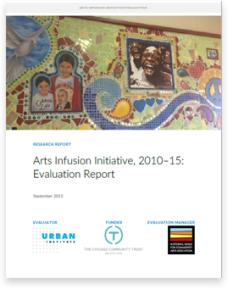
Author: Urban Institute
Publication Year:
Media Type: Report
Summary:
In 2010, an ambitious model for social change emerged in Chicago that aimed to connect detained youth and those at risk for incarceration (“at-risk youth”1) to rigorous and engaging arts instruction, infused with social and emotional learning goals. Dubbed the Arts Infusion Initiative, the Chicago Community Trust (“the Trust”) spearheaded and funded this five year, $2.5 million demonstration while earning cooperation from the local detention facility, public school system, community policing office, and community arts program leaders to integrate arts programming into youths’ school and after school environments. Since its launch, the Arts Infusion Initiative2 has served more than 2,000 youth at an average annual cost of $700 per teen, linking them to high performing arts instruction associated with significant increases in social and emotional learning. [p. 3]
Abstract:
In 2010, an ambitious model for social change emerged in Chicago that aimed to connect detained youth and those at risk for incarceration (“at-risk youth”1) to rigorous and engaging arts instruction, infused with social and emotional learning goals. Dubbed the Arts Infusion Initiative, the Chicago Community Trust (“the Trust”) spearheaded and funded this five year, $2.5 million demonstration while earning cooperation from the local detention facility, public school system, community policing office, and community arts program leaders to integrate arts programming into youths’ school and after school environments. Since its launch, the Arts Infusion Initiative2 has served more than 2,000 youth at an average annual cost of $700 per teen, linking them to high performing arts instruction associated with significant increases in social and emotional learning.
This report marks the first large-scale evaluation of the Arts Infusion Initiative which was designed to: (1) assess the degree to which the project, as an emergent model for social change, was achieving its intended purposes and (2) generate actionable information for promoting effective Arts Infusion practices while redirecting those that have been less effective. To accomplish these objectives, from April to August 2015, the Urban Institute (“Urban”), in consultation with the National Guild for Community Arts Education (“the National Guild”), conducted a multi-method evaluation that drew on the following sources:
- Five years of Arts Infusion documentation, including arts programs’ teaching unit plans for infusing social and emotional skills instruction, proposals and final reports, assessments of youths’ social and emotional progress, and knowledge sharing activities, attendance, and participant feedback;
- Quantitative analysis of the initiative’s 2014–15 social and emotional youth assessment data (n=320);
- More than six dozen (n=73) interviews and focus groups with Arts Infusion instructors, program directors, youth participants, and community stakeholders;
- An online survey assessing stakeholders’ (n=45) perceptions of the initiative, conducted by Urban during the evaluation period; and
- Observations of more than a dozen Arts Infusion classes, events, and performances, as well as artwork (music, poetry, dance, theatre, and visual art) produced by teen and young adult participants. [p. 3-4]
Arts & Intersections:
Categories: Prisons and Rehabilitation, Creative Youth Development
ADDITIONAL BIBLIOGRAPHICAL INFORMATION
PUBLISHER INFORMATION
Name: Chicago Community Trust
Website URL: http://cct.org/